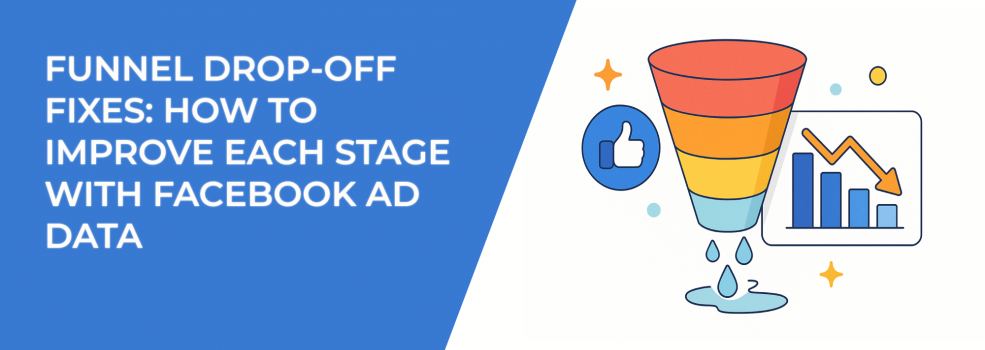Click. Bounce. Vanish.
It’s a story every marketer knows too well. You’ve built your funnel, run the ads, and launched the campaign. Your metrics should be better. But somewhere between awareness and conversion, your audience leaks out.
Understanding why and more importantly, how to fix it, starts with how you use your Facebook ad data. Not just tracking performance, but diagnosing the friction behind every drop-off.
Let’s break it down. Stage by stage.
Top of Funnel (TOFU): Turn Awareness Into Engagement
You’re buying attention. The question is — what are you earning from it?
The top of your funnel exists to make people aware of your brand, product, or offer. It’s not about selling. It’s about stopping the scroll, generating curiosity, and inviting the right users into your world.
But TOFU drop-off is common — and most advertisers don’t catch it early enough.
Here are some key metrics to monitor at this stage:
-
Scroll Depth / Video Watch Time: Are users bailing after 2–3 seconds? That’s a weak hook.
-
CTR (Click-Through Rate): Is your message connecting?
-
Cost Per ThruPlay or Engagement: Are you paying too much just to be ignored?
If the numbers suggest your top-funnel content isn’t connecting, try these tactics:
-
Segment your creative by persona. Generic messaging dilutes results. If you’re targeting multiple demographics, don’t expect one-size-fits-all content to work. Test creatives for different interest buckets or behaviors — and check Facebook’s Breakdown tool to see what resonates.
-
Look at relevance diagnostics. These tell you how your ad stacks up against others competing for the same audience. A low Engagement Rate Ranking usually means your ad is being ignored.
-
Avoid “spray and pray.” Use Lookalike Audiences built from high-intent seed groups: engaged video viewers, long-time customers, even top spenders. That’s how reach becomes qualified reach.
For example, if a video ad is getting a decent CTR but poor retention, the hook might be too slow. Try front-loading value — stats, emotions, or questions — within the first 2 seconds.
And if you want to go deeper? Build engagement-based Custom Audiences — such as 75% video viewers or post engagers. This sets you up for stronger, more relevant retargeting later on.
If your creatives aren’t capturing attention in the first few seconds, you might need to rethink your approach — here's a deeper dive into how to hook your target audience using Facebook ad psychology.
Middle of Funnel (MOFU): Make Them Want to Care
TOFU built curiosity. MOFU builds trust. But this is where your funnel often springs the biggest leaks.
Why? Because interest is fragile. Your prospect clicked… but now they’re questioning if it’s worth their time.
Here are the metrics that reveal what's happening:
-
Landing Page Views vs. Link Clicks: A big discrepancy here means users are bouncing before your page loads — possibly due to a slow site or disconnect between ad and page.
-
Engagement Drop-Off in Retargeting Ads: If your MOFU ads underperform, content relevance might be the problem.
-
Time on Site, Scroll Depth, and Bounce Rate: These indicate how well the landing experience follows through on your ad’s promise.
When your MOFU performance lags, try the following:
-
Match message to experience. If your ad promises “instant results,” your landing page should deliver something tangible and fast.
-
Use segmented retargeting. Don’t lump all visitors together. Someone who watched 90% of a video or scrolled through your product page deserves different messaging than someone who bounced instantly.
-
Introduce social proof strategically. MOFU is the time to retarget with testimonials, UGC, or third-party validation. If you can, personalize content by segment using Dynamic Creative.
Think of MOFU as your testing zone. You’re warming up your audience, and drop-off is expected. But when your Facebook ad data tells you where and why users are leaving, you can act with precision — not guesswork.
Ask yourself: what expectation did my TOFU ad set — and did the next step live up to it?
At this stage, choosing the right audience strategy is crucial — explore the pros and cons of retargeting versus broad targeting for Facebook ads.
Bottom of Funnel (BOFU): Eliminate Hesitation, Build Confidence
At this point, users are informed and interested — but still unsure. This is where the “almosts” stack up: add-to-carts, checkout initiations, abandoned sessions.
Many advertisers focus too much on increasing volume at this stage, rather than resolving hesitation.
Here’s what to watch in your Facebook data:
-
Add-to-Cart but No Purchase Rate: A clear signal of last-mile friction.
-
Initiated Checkout but Drop-Off: Users are serious — something spooked them.
-
Return Frequency of Retargeting Ads: Too much overlap? You may be causing ad fatigue.
Once you’ve spotted these patterns, act with tailored solutions:
-
Use Facebook’s Conversion Event data to build smarter BOFU segments. Segment by behavior — not just by pageview — and speak directly to where they left off.
-
Deploy Dynamic Product Ads (DPAs). Serve personalized reminders of what they viewed or added to cart, paired with urgency or relevance.
-
Introduce risk-reducers. If drop-offs happen at the pricing stage, test messaging around guarantees, refund policies, or payment flexibility.
Don't forget about attribution blind spots. iOS privacy changes have reduced the visibility of some user actions. Implementing Facebook’s Conversion API ensures you capture more accurate BOFU performance data.
Real-world scenario: a retailer notices a spike in mobile checkout drop-offs. Facebook’s platform shows it’s mostly Android users. After a UX review, they discover the checkout button was partially hidden on certain devices. One simple design fix boosts conversions by 18%.
If performance is dipping despite consistent traffic, you might be dealing with ad burnout — here’s how to spot ad fatigue and recover fast.
Post-Purchase (Loyalty Stage): Don’t Let the Funnel Die Here
Most funnels stop at the sale. That’s a mistake.
This stage is where Customer Acquisition Cost (CAC) gets offset, and where Lifetime Value (LTV) really starts to grow. Facebook ads still have a role to play — especially in retention, referrals, and reactivation.
Use your Facebook data to power smarter post-purchase strategies:
-
Build Lookalikes of high-LTV customers.
-
Segment repeat buyers and one-timers.
-
Trigger loyalty offers or review requests based on behavior and timing.
From there, here’s how to activate those insights:
-
Suppress buyers from BOFU campaigns immediately. Avoid wasting budget by excluding recent converters and instead shift them into post-purchase sequences.
-
Run “referral loop” campaigns. Incentivize sharing or referrals using paid content aimed at recent customers.
-
Track ROAS over time. Use Facebook performance data combined with CRM or Shopify data to understand long-term campaign profitability.
One advanced move? Ad sequencing. Show a thank-you message first, then deliver educational content, then promote a relevant cross-sell. These sequences increase LTV and brand affinity — all within your existing ad spend.
The Real Fix: Connecting the Funnel to the Data
The beauty of Facebook ads isn’t just their reach — it’s the data they generate. Every interaction tells a story. Every drop-off signals something deeper.
But too often, marketers run campaigns without mapping them to funnel stages, audience mindset, or true performance outcomes.
Here’s how to start connecting the dots:
-
Stop optimizing for vanity metrics. CTR is good. Conversion rate is better. LTV per audience segment is best.
-
Use Facebook reporting to isolate weak stages. Find out not just where drop-offs occur, but why.
-
Let data drive your creative and targeting decisions. Use insights, not assumptions, to shape your strategy.
When you start thinking this way, funnels don’t feel like linear pipelines. They become ecosystems of signals, behaviors, and opportunities to reconnect.
Final Thought: Funnels Don’t Fail All at Once
They fail in pieces. One weak hook. One slow load. One misaligned message. All fixable.
Your Facebook ad data can’t patch the funnel by itsel, but it can tell you exactly where to start.
So the real question is: are you just watching your metrics or actually listening to them?

